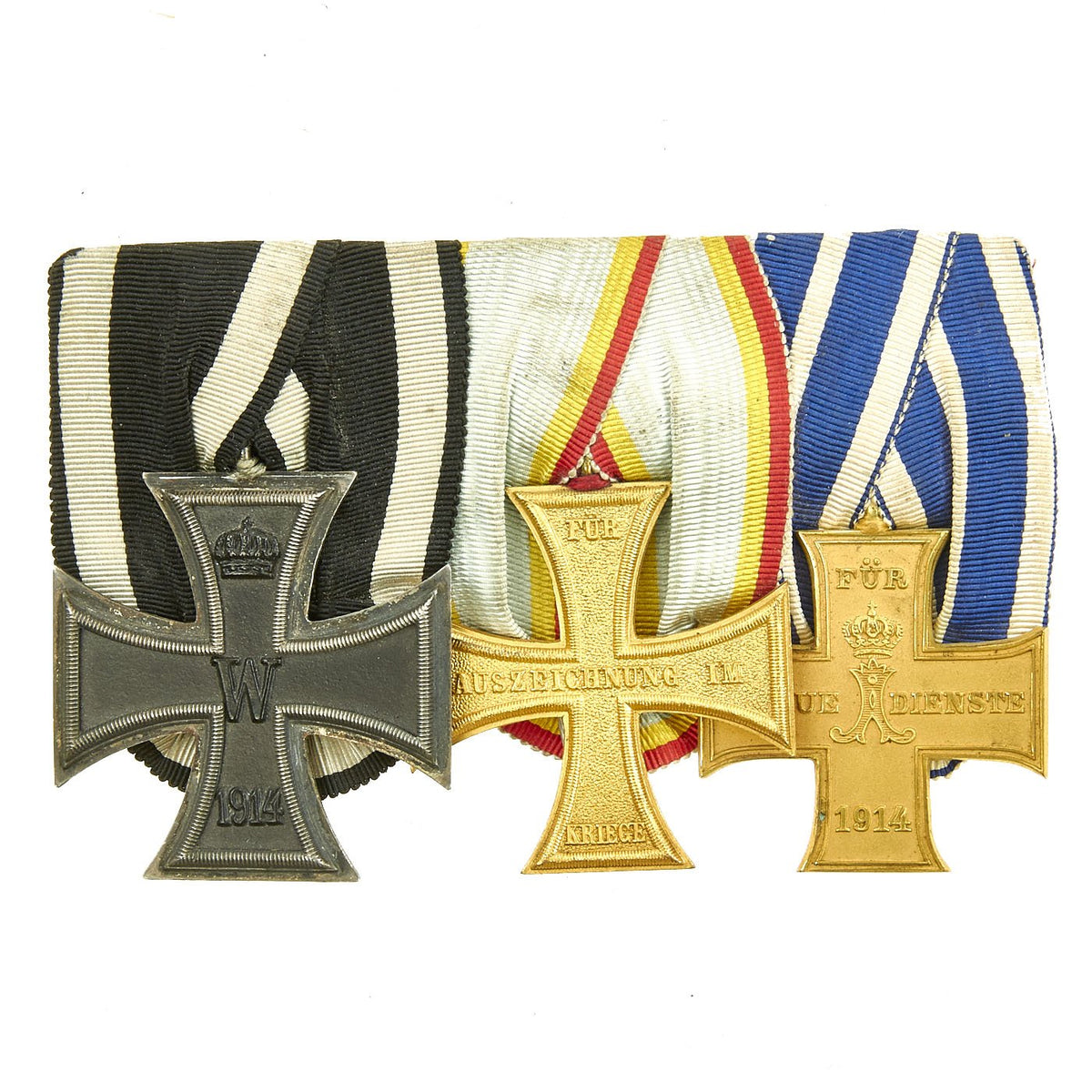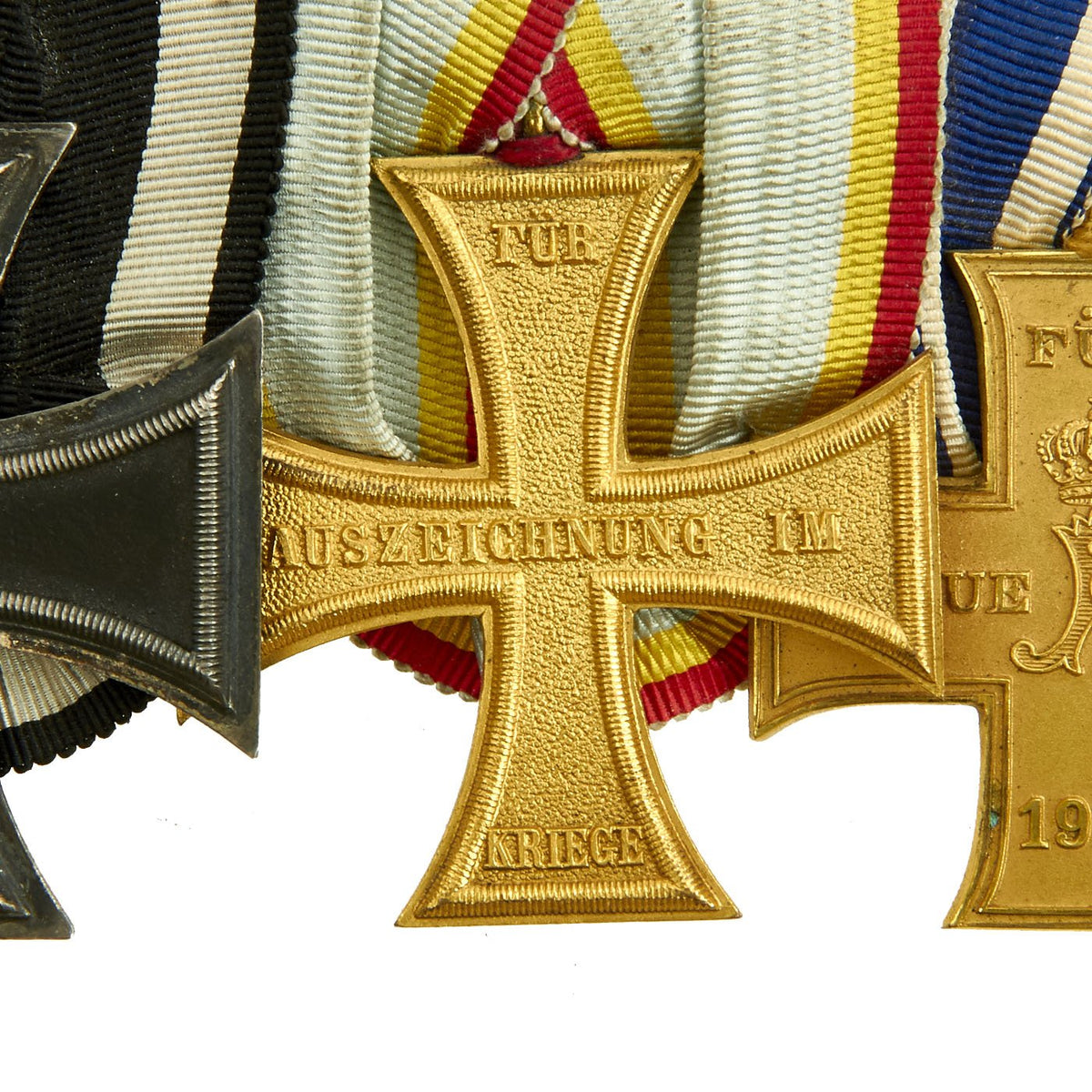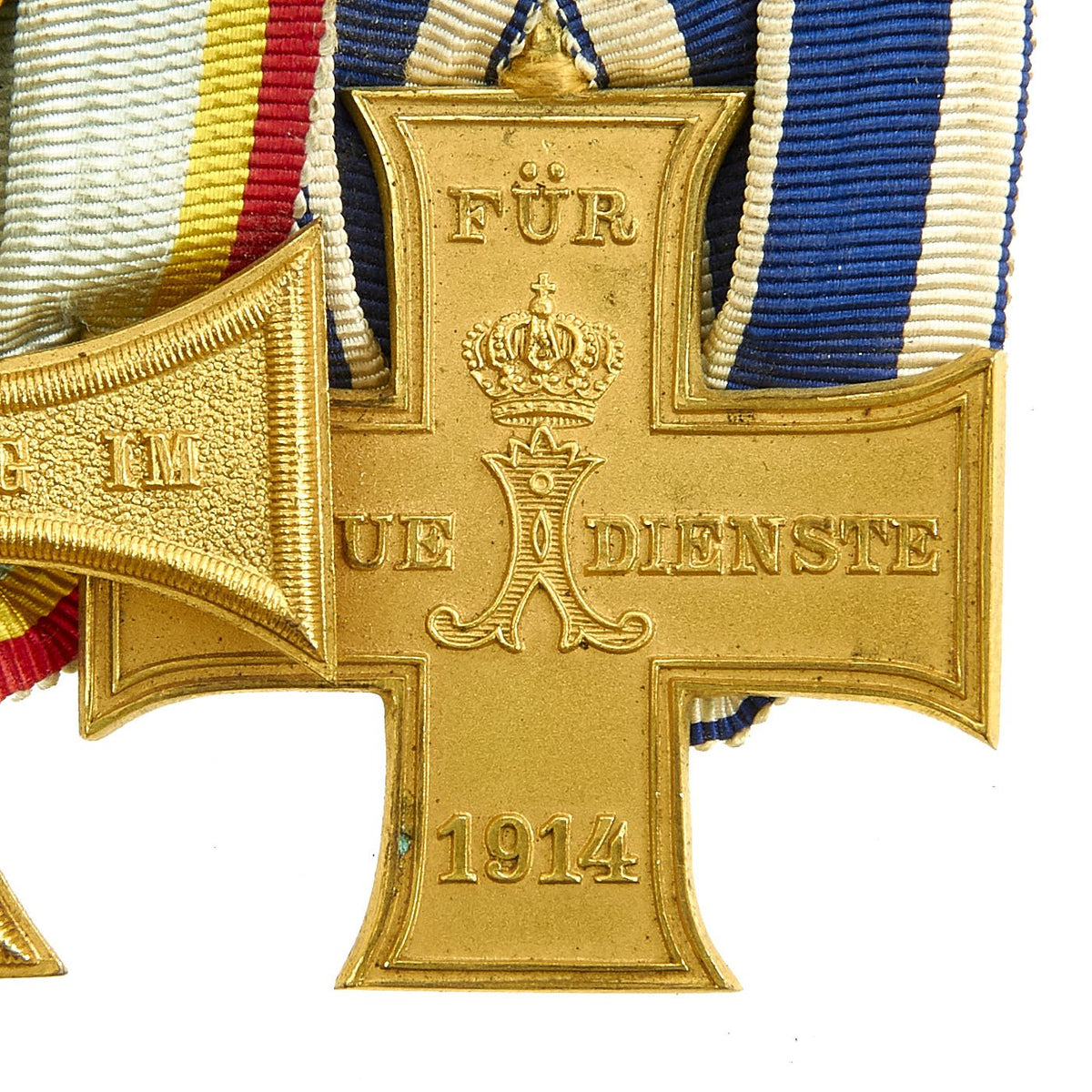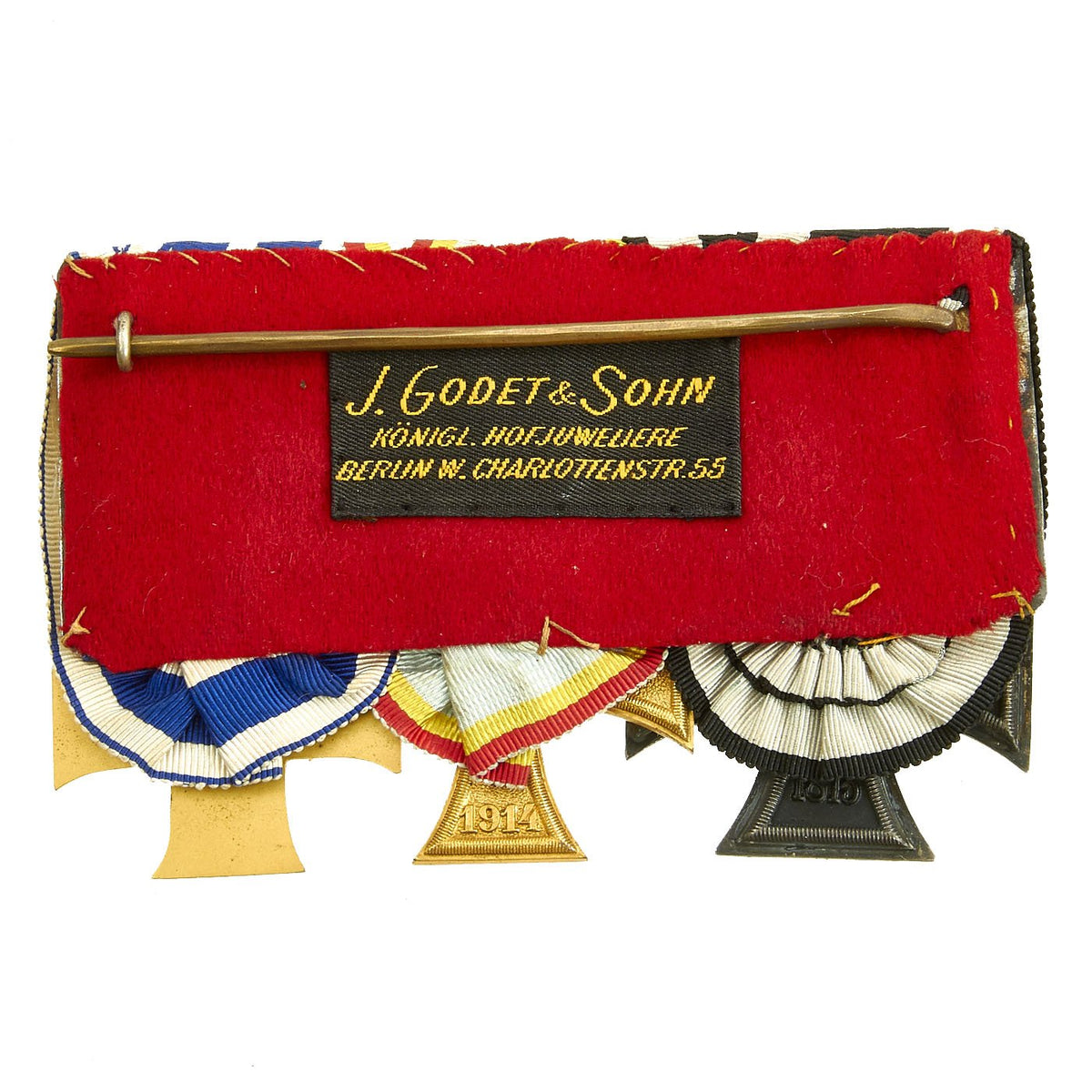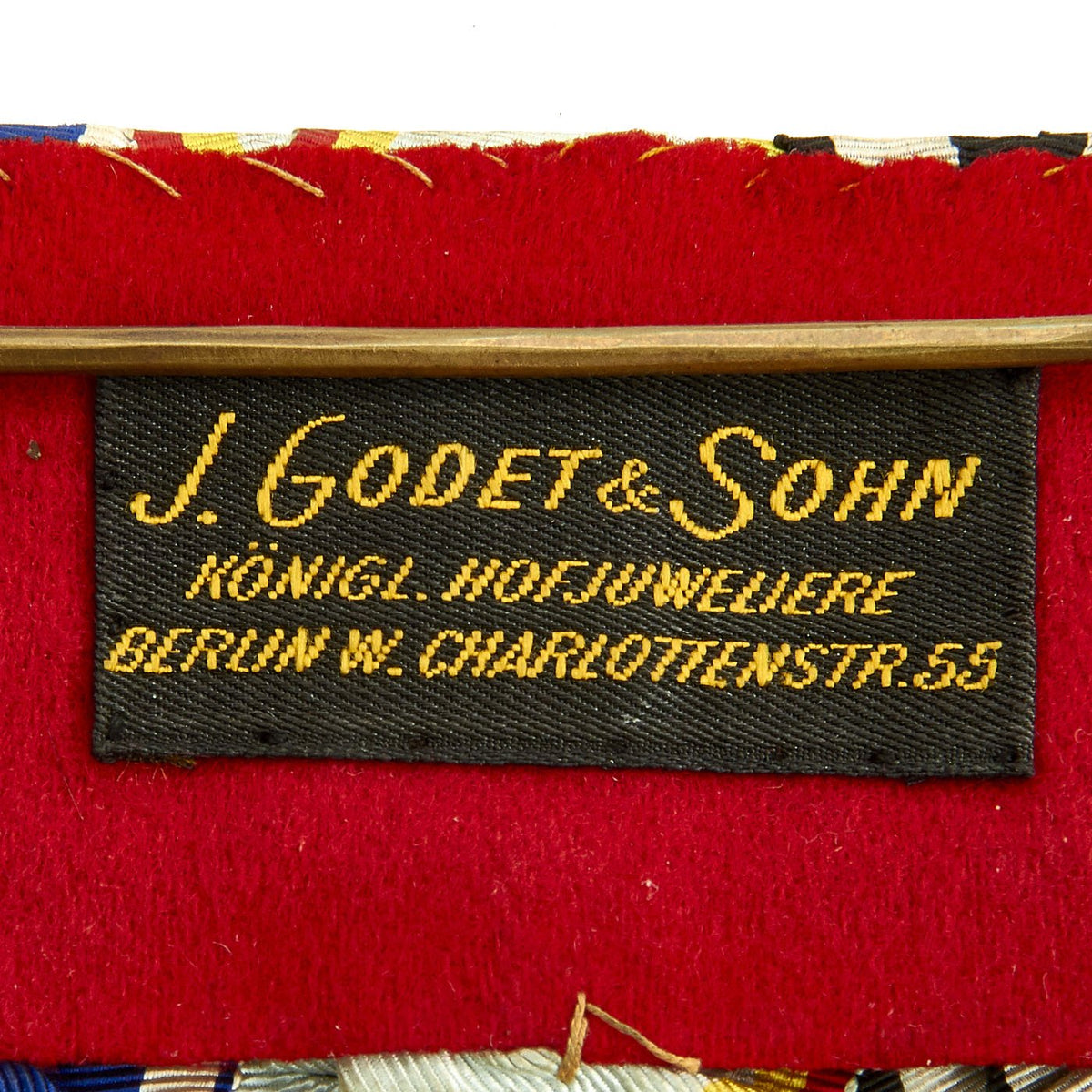Original German WWI Medal Bar with Iron Cross 2nd Class, Schaumburg-Lippe & Mecklenburg-Schwerin Service Crosses Original Items
$ 395,00 $ 118,50
Original Item: One-of-a-kind. This is fantastic a 100% genuine medal bar removed from the uniform of a fallen or captured German soldier during WWI, and brought home by an American soldier as a war trophy. It features awards from both the Grand Duchy of Mecklenburg-Schwerin and the Principality of Schaumburg-Lippe, which are two awards we have never seen before! Foremost however is the the iconic Iron Cross in the left most position.
The medals and ribbons are attached to a very nice metal backing with red felt padding, with a nice hinged attachment pin. There is also a maker label for J. GODET & SOHN, who put together the ribbon bar.
The set of 3 medals consists of the following:
– WWI Iron Cross 2nd Class (Eisernes Kreuz 2. Klasse, or EKII)
– WWI Grand Duchy of Mecklenburg-Schwerin 1914 Military Merit Cross 2nd Class
– WWI Principality of Schaumburg-Lippe 1914 Cross For Loyal Service
Iron Cross (Eisernes Kreuz) 2nd Class:
Emperor Wilhelm II reauthorized the Iron Cross on 5 August 1914, at the start of World War I. During these three periods, the Iron Cross was an award of the Kingdom of Prussia, although – given Prussia’s pre-eminent place in the German Empire formed in 1871 – it tended to be treated as a generic German decoration. The 1813, 1870, and 1914 Iron Crosses had three grades.
The Iron Cross 1st Class and the Iron Cross 2nd Class were awarded without regard to rank. One had to possess the 2nd Class already in order to receive the 1st Class (though in some cases both could be awarded simultaneously). The egalitarian nature of this award contrasted with those of most other German states (and indeed of many other European monarchies), where military decorations were awarded based on the rank of the recipient. For example, Bavarian officers received various grades of that Kingdom’s Military Merit Order (Militär-Verdienstorden), while enlisted men received various grades of the Military Merit Cross (Militär-Verdienstkreuz). Prussia did have other orders and medals which it awarded on the basis of rank, and even though the Iron Cross was intended to be awarded without regard to rank, officers and NCOs were more likely to receive it than junior enlisted soldiers.
Please note the edge seam for authentication, which is not present on reproductions. Iron crosses were commonly constructed from an iron core sandwiched in a surrounding two part silver frame, normally the seam of these two silver parts is visible around the edge of the cross as is seen on this fine example.
The Grand Duchy of Mecklenburg-Schwerin Military Merit Cross 1914
The Military Merit Cross (Militärverdienstkreuz) was established by Friedrich Franz II, Grand Duke of Mecklenburg-Schwerin on August 5, 1848. Mecklenburg-Schwerin, a grand duchy located in northern Germany, was a member of the German Confederation and later the German Empire.
In several respects, Mecklenburg-Schwerin’s Military Merit Cross was patterned after the Prussian Iron Cross. Both came in two classes, a pinback 1st Class and a 2nd Class worn from a ribbon, both were awarded without regard to rank (most other orders and medals of both states were awarded in different classes based on the rank or status of the recipient), and both were awarded for specific campaigns, as indicated by a date on the bottom arm of the cross. However, there were more versions of the Mecklenburg cross than of the Prussian cross (which was only awarded by Prussia in the Napoleonic Wars, the Franco-Prussian War and World War I, and by NSDAP Germany in World War II).
The second class award has the text FÜR AUSZEICHNUNG IM KRIEGE (For Award In War) on the front, and the back has a crown at the top, with an FF for Friedrich Franz II in the middle, and 1914 on the bottom.
The Principality of Schaumburg-Lippe 1914 Cross For Loyal Service
The Cross for Loyal Service (Kreuz für Treue Dienste) was instituted 18 November 1914 by Prince Adolph II. It was based on the Cross founded by his grandfather, Prince Adolph I for the Franco-Prussian War of 1870-1871
The front features a central monogram of Prince Adolph II, with the arms bearing an inscription of FÜR TREUE DIENSTE 1914. During the WWI period, each of the German states had their own awards for valor and merit, and this is a somewhat rare example, being from such a small principality.
Fast Shipping with Professional Packaging
Thanks to our longstanding association with UPS FedEx DHL, and other major international carriers, we are able to provide a range of shipping options. Our warehouse staff is expertly trained and will wrap your products according to our exact and precise specifications. Prior to shipping, your goods will be thoroughly examined and securely secured. We ship to thousands clients each day across multiple countries. This shows how we're dedicated to be the largest retailer on the internet. Warehouses and distribution centres can be located throughout Europe as well as the USA.
Note: Orders with more than one item will be assigned a processing date depending on the item.
Before shipping before shipping, we'll conduct a thorough inspection of the items you have ordered. Today, the majority of orders will be delivered within 48 hours. The delivery time will be between 3-7 days.
Returns
The stock is dynamic and we cannot completely manage it because multiple stakeholders are involved, including our factory and warehouse. So the actual stock may alter at any time. It's possible that you may not receive your order once the order has been made.
Our policy is valid for a period of 30 days. If you don't receive the product within 30 days, we are not able to issue a refund or an exchange.
You can only return an item if it is unused and in the same state as the day you received it. You must have the item in its original packaging.
Related products
Uncategorized
Uncategorized
Uncategorized
Angolan Rebel 1970s era 60mm Inert Display Mortar from Angolan Civil War Original Items
Uncategorized
Uncategorized
Uncategorized
Uncategorized
Uncategorized
Uncategorized
Uncategorized
Armoured Fighting Vehicles of the World: AFVs of World War One (Hardcover Book) New Made Items
Uncategorized
Uncategorized
Uncategorized
Uncategorized
Band of Brothers ORIGINAL GERMAN WWII Le. F.H. 18 10.5cm ARTILLERY PIECE Original Items
Uncategorized
Uncategorized
Uncategorized
Uncategorized
Uncategorized
